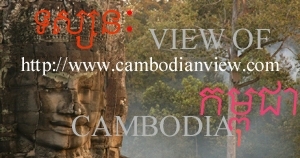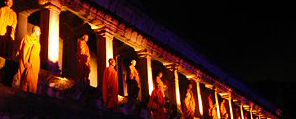
Natthi santi param sukham
-Dhammapada, XV.202
No bliss is greater than the Perfect Peace.

Smouth
Worship TripleGem
Worshipping
Triple Gem
Parita Sutta & Abhidhamma
Khmer in Canada
with their
invaluable culture awareness
Para Pavasutta
Life of Khmer Women
Mohori Classical Music
Song Of Cambodians
Dhamma Sangveka1
Darkness of the Past
Khmer Pinpeat Music 1
Khmer Pinpeat Music2
Hi
everybody !
Welcome to cambodianview.com, here is the great step of yours to surf this
new homepage. You could experience and learn more about Khmer through your
treading in here.
Cambodianview.com will satisfy you to fulfil your pasion of knowledge about
the worldview, perspectives and vision of Cambodians.
This vision stands on the righteousness. And this righteouness was informed
by Lord Buddha.
So how could Buddhism shares the visions for Cambodia to strengthen its unity,
peace, development and true happiness. Also how could we apply the invaluable
treasure of Buddhism to develope economic and also territory integrety of
Cambodia?.
This homepage will deal with collecting Dhamma Preaching from various Khmer
well-known monks, laypeople, music, Buddhist academic writtings, Buddhism
for beginners, social activities of Cambodian community, every Khmer links,
news and the rest...
We also, webmasters, will apologize for any unconvenience of surfing this
homepage.
With Metta Dhamma
Webmaster Group!
Special Links:
Khmer
Temple in Calgary
Khmer Authentic Language
Cambodian Language
School
Special Thanks to :
- Saramak Keir
- Pen Song Ly
- Pen Kelin
Khmer Language (General Perspectives and History)
GENERAL INTRODUCTION
Khmer, or Cambodian, is spoken by some 7 million people and is the official
language of Cambodia where 90 percent of the population--about 6 million
people--speaks it as a first or second language. Speakers also live in Vietnam
(700,000), and Thailand (320,000). Smaller communities are found in the
USA, France and Laos.
LINGUISTIC AFFILIATION
Khmer belongs to the Mon-Khmer family of the Austroasiatic phylum. The Mon-Khmer
family has over 100 members, which are spoken throughout much of Southeast
Asia, mainly in Laos, Vietnam, and Cambodia, but also in Thailand, Burma,
and the Malay Peninsula. They are Austroasiatic languages that include the
Munda languages of India; these in turn are possibly related very distantly
to the Tai or Dai languages of Thailand, Laos, northern Vietnam, Burma,
southern China, and Hainan Island in the Gulf of Tonkin. Khmer's best known
closest relative is Vietnamese.
LANGUAGE VARIATION
The dialect picture in Cambodia is not well understood, but regional differences
are slight and usually mutually intelligibile. Modern Standard Khmer--which
is based on the Phnom Penh dialect--is understood and used throughout the
country. However variants spoken by communities outside the national boundaries
include: Northern Khmer, or Surin, spoken in Thailand just north of the
Cambodia border; Southern Khmer, or Khmer Krom, spoken in southern Vietnam;
and Western Khmer, spoken in Thailand. These are considered mutually intelligible,
dialectal variants, but authorities recognize Northern Khmer (Surin) as
a distinct but closely related language.
ORTHOGRAPHY
Khmer script evolved from Pallava, a variant of the Davanagari script used
to write Sanskrit, Hindi, and other Indian languages. It is essentially
an alphabetic, phonologically-based, system--with some elements of a syllabic
system--which involves some complexity. For example, there are two sets
of symbols for consonants while the number of graphs for vowels are not
sufficient to symbolize the full range of distinctions; thus, the vowel
sign is interpreted differently depending on which consonant symbol it is
paired with.
LINGUISTIC SKETCH
Khmer is a language that is devoid of inflection in either nouns or verbs;
this type of language is sometimes referred to as isolating. For nouns,
number is inferred from context although there are modifiers--such as words
equivalent to "some," "all," and the numeral "two"
in English--which can be used to indicate plural. There are no articles
marking a definite/indefinite distinction. Gender is unmarked but distinctions
can be made by using kinds of modifiers that have inherent referential gender,
such as words for "son," "daughter," "male,"
and "female."
Verbs are unmarked for tense, aspect, mood, and other categories. These, if marked at all, are indicated by auxiliaries, which can precede or follow the verb.
The system of personal pronouns is fairly rich; it is sensitive to the social standing of interlocutors, such as perceived status, age, and level of intimacy.
There is a nonproductive morphology whereby prefixes and infixes can, for example, derive causative type verbs from simple verbs ("push down" from "go down," "put to sleep" from "sleep," "teach" from "learn") and reciprocals from simple verbs ("love one another" from "love") or nouns from verbs ("birth" from "be born"), and so on.
Grammatical relations are signaled by word order with the help of various particles. Genitive constructions are formed by juxtaposing the noun possessed followed by the possessor. Normal word order is Subject - Verb - Object. Modifiers typically follow the noun , but numerals often come before unless a numerical classifier is used and then both numeral and classifier follow. (Numeral classifiers do not play as important a role in Khmer as they do in Thai).
Khmer has a very rich phonological system consisting of twenty-five to twenty-seven short and long vowel phonemes, depending on dialect (with Northern Khmer having as many as thirty). There are seventeen to twenty-one consonant phonemes in the inventory. The language is nontonal; there is stress and it tends to fall on the final syllable. Morpheme structure allows numerous consonant clusters word-initially (some quite uncharacteristic of what English-speakers are used to), but none finally and the number of consonants allowed in word-final position are less than the total number in the language.
Most native words are monosyllabic or consist of a semi-syllable (unstressed with a reduced vowel) followed by a single syllable. There are many polysyllabic words, mainly of a literate character, which have been borrowed from Sanskrit and Pali. Khmer has also borrowed from Thai, Vietnamese, Chinese, and French.
ROLE IN SOCIETY
Khmer is the national and official language of Cambodia and is used in the
media, taught in the schools at all levels (with some exceptions in higher
educational institutions), used in government administration, in the judiciary,
and in most social, everyday, contexts.
The Chinese and Vietnamese communities are large and there are many smaller communities with speakers totaling from several hundred to several tens of thousands. The Cambodian constitution recognizes the right of these communities to maintain and teach their own language, but in practice, because of a lack of orthographies, most speakers of these languages become literate in Khmer.
There is also a type of diglossia prevalent between monks and the laity in which a specialized vocabulary, unrelated to the common one, is used. There was also another specialized vocabulary that was used by the royalty and by commoners when speaking about them. The same style could also be used by anyone to indicate distance and courtesy before the monarchy ceased to exist in 1975.
HISTORY
The history of the language is distinguished into several periods: Old Khmer
(the seventh to eighth century), Angkor period (the ninth to fifteenth century),
Middle Khmer (the sixteenth to eighteenth century), and Modern Khmer. The
language is attested from the earliest periods by numerous inscriptions,
and then during the Middle Khmer period by extensive writings on palm leaf
manuscripts, including the Khmer version of the Ramayana, a well-known Hindu
epic about Rama.
Most of the learned vocabulary for administration, military, and literature is borrowed from Sanskrit. With the introduction of Theravada Buddhism at the beginning of the fifteenth century, Pali became an important source of new vocabulary. During French colonial hegemony, many French loans entered the language.
During the Angkor period, Khmer influenced the surrounding languages, especially the unrelated languages of Lao and Thai, and they borrowed heavily from Khmer.
As a consequence of Khmer nationalism that emerged in the 1960s, linguistic purity became an issue. A committee was established that focused on the creation of neologisms using indigenous linguistic devices rather than borrowing from Sanskrit or Pali. The Khmer Rouge regime also left a linguistic legacy in expunging certain linguistic features which reflected social status.
ACADEMIC RESOURCES
Only three institutions in North America teach Khmer (Linguistic Society
of America 1992).
REFERENCES
Campbell, G. L. 1991. Compendium of the World's Languages, Vol. 1 -2. London
and New York: Routledge.
Diffloth, G. 1992. "Khmer." In W. Bright, ed. International Encyclopedia of Linguistics, Vol. 2:271-275. New York and Oxford: Oxford University Press.
Grimes, B. F., ed. 1992. Ethnologue, Languages of the World. Dallas, TX: Summer Institute of Linguistics.
Linguistic Society of America. 1992. Directory of Programs in Linguistics in the United States and Canada. Washington, DC: Linguistic Society of America.
Ruhlen, M. 1987. A Guide to the World's Languages, Vol. 1: Classification. London: Edward Arnold.
Smyth, D. A. 1994. "Cambodia: Language Situation." In R. E. Asher, ed. The Encyclopedia of Language and Linguistics, Vol. 2:440. Oxford: Pergamon Press.
_____. 1994. "Cambodian." In R. E. Asher, ed. The Encyclopedia of Language and Linguistics, Vol. 2:440-441. Oxford: Pergamon Press.
   |
|
|
|
|
|
About Us
| Cambodian Links | Contact
Us
Copyright ©August, 2003 Khmer-Canadian Buddhist Cultural Centre. All Rights Reserved (unless otherwise stated). Started: Wed, August 13, B.E.2547,A.D.2003, Last Updated: October 29, 2547 |
|